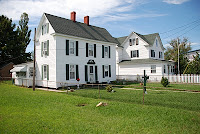
Leaving Dubai in the early morning, the sun was shining nicely on the Burj Kalifa, so we stopped and took a couple of photographs. It really is a graceful building and deceptive about its height.
We drove east to the Gulf of Oman, through the town called Friday's Market, and up by Dibba, doing some bird watching and countryside looking along the way. Peter wanted to find certain birds, and we did spot one. He has an incredible eye for this, spotting and identifying birds that I barely notice.
We saw wild camels wandering around in the desert (well, they pr

obably belonged to someone), and triangular "camel crossing" signs along the road.
The country become very mountainous as you proceed out there to the east, and then you drop down to the sea. We stopped at a little beach resort, called Sunny Beach, which is just even with a big rock formation called "Snoopy" that is about two hundred yards off shore. We bought a day entry, rented flippers and a mask (Peter hired scuba gear), and we went snorkeling and scuba diving.
Actually the 10 o'clock scuba trip was taken over by a class, so we went snorkeling around the island called Snoopy. It looks like Snoopy in profile laying down on his back.
We could not go out on the boat until 1 p.m. So we had lunch on the patio overlooking the water, and it was quite pleasant sitting in the sunshine with a gentle breeze off the water. Eventually large bus loads of corpulent Russians and Germans began arriving.
But, before they began to block our view of the sea, we set off in a dive boat with four Norwegians and a young American couple. It takes a long time to put on all the equipment for scuba diving, and the mask and fins for snorkeling were comparatively quick. We did dives on two different spots. Saw lots of coral reef fish with bright colors of blue and yellow, but I cannot identify them even when I have a reference book later.

It was about five o'clock by the time we got back to shore and cleaned the salt water off, took a few pictures, and got back in the car. We drove down through Badiya where there is a really old mosque right beside the road. It was built in about 1493 or so, out of mud, and said to be the oldest mosque in UAE. Its amazing anything lasts that long!
Then we continued down to Khor Fakkan, Fujairah and turned back toward Dubai. The coast is very pretty and green, and it is relatively unspoiled by development until now, at least as compared to Dubai. It is obvious why UAE residents like to drive out here for the day to swim, picnic, and enjoy the cooler atmosphere.
On the way back to Dubai, we noticed lots of cars and

SUV's pulled off on the side of the road or even out in the desert. (Going off road into the desert is not something you do with the average SUV; most standard street SUV's would quickly get stuck in the sand.) Often, a few hundred yards away from the highway, there was a campfire, and in many cases a tent had been erected. Many times we noticed the boys driving ATV's through the dunes. In other cases you saw groups of men circling the campfire. No women were anywhere to be seen.
The Emiratis, remembering their heritage as nomadic tribesmen, still like to go out to the desert and go camping. In America, fathers take their sons camping; in Arabia, fathers take their sons camping. It is just the difference between being the woods and being out in the desert, under the stars.






















 the self-declared "world's only seven-star hotel" -- the Burj Al-Arab. The shape of the building is like that of an Arab ship's sail, and it is said that some Middle East royalty keep a suite here at all times, just in case they decide to come by on short notice. Of course, it stands on its own man-made island. I understand you have to make a reservation about three days in advance just to visit for a coffee or lunch. If you wonder why I am not staying here, the smallest suite is about 1,820 sq ft and the per night cost begins at $2,000. The larger suites go up to 8400 sq ft and cost $28,000 per night. Not within my allowance.
the self-declared "world's only seven-star hotel" -- the Burj Al-Arab. The shape of the building is like that of an Arab ship's sail, and it is said that some Middle East royalty keep a suite here at all times, just in case they decide to come by on short notice. Of course, it stands on its own man-made island. I understand you have to make a reservation about three days in advance just to visit for a coffee or lunch. If you wonder why I am not staying here, the smallest suite is about 1,820 sq ft and the per night cost begins at $2,000. The larger suites go up to 8400 sq ft and cost $28,000 per night. Not within my allowance.











